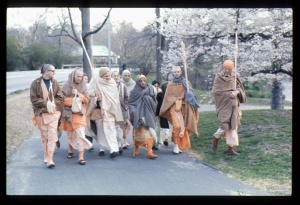CC Madhya 13.67: Difference between revisions
m (1 revision(s)) |
No edit summary |
||
| Line 1: | Line 1: | ||
{{ | [[Category:Sri Caitanya-caritamrta - Madhya-lila Chapter 13|C067]] | ||
<div style="float:left">'''[[Sri Caitanya-caritamrta|Śrī Caitanya-caritāmṛta]] - [[CC Madhya|Madhya-līlā]] - [[CC Madhya 13|Chapter 13: The Ecstatic Dancing of the Lord at Ratha-yātrā]]'''</div> | |||
<div style="float:right">[[File:Go-previous.png|link=CC Madhya 13.66|Madhya-līlā 13.66]] '''[[CC Madhya 13.66|Madhya-līlā 13.66]] - [[CC Madhya 13.68|Madhya-līlā 13.68]]''' [[File:Go-next.png|link=CC Madhya 13.68|Madhya-līlā 13.68]]</div> | |||
{{CompareVersions|CC|Madhya 13.67|CC 1975|CC 1996}} | |||
{{RandomImage}} | |||
==== TEXT 67 ==== | ==== TEXT 67 ==== | ||
<div | <div class="verse"> | ||
bhakta-gaṇa anubhave, nāhi jāne āna | :bhakta-gaṇa anubhave, nāhi jāne āna | ||
śrī-bhāgavata-śāstra tāhāte pramāṇa | :śrī-bhāgavata-śāstra tāhāte pramāṇa | ||
</div> | </div> | ||
| Line 12: | Line 16: | ||
==== SYNONYMS ==== | ==== SYNONYMS ==== | ||
<div | <div class="synonyms"> | ||
bhakta- | ''bhakta-gaṇa''—all devotees; ''anubhave''—could perceive; ''nāhi jāne''—do not know; ''āna''—others; ''śrī-bhāgavata-śāstra''—the revealed scripture ''Śrīmad-Bhāgavatam''; ''tāhāte''—in that connection; ''pramāṇa''—evidence. | ||
</div> | </div> | ||
| Line 19: | Line 23: | ||
==== TRANSLATION ==== | ==== TRANSLATION ==== | ||
<div | <div class="translation"> | ||
Śrī Caitanya Mahāprabhu’s dancing before the Ratha-yātrā car could be perceived only by pure devotees. Others could not understand. Descriptions of Lord Kṛṣṇa’s uncommon dancing can be found in the revealed scripture Śrīmad-Bhāgavatam. | Śrī Caitanya Mahāprabhu’s dancing before the Ratha-yātrā car could be perceived only by pure devotees. Others could not understand. Descriptions of Lord Kṛṣṇa’s uncommon dancing can be found in the revealed scripture Śrīmad-Bhāgavatam. | ||
</div> | </div> | ||
| Line 26: | Line 30: | ||
==== PURPORT ==== | ==== PURPORT ==== | ||
<div | <div class="purport"> | ||
Lord Śrī Kṛṣṇa expanded Himself into many forms while engaged in the rāsa-līlā dance, and He also expanded Himself when He married 16,000 wives in Dvārakā. The same process was adopted by Śrī Caitanya Mahāprabhu when He expanded Himself into seven forms to dance in each and every group of the saṅkīrtana party. These expansions were appreciated by pure devotees, including King Pratāparudra. Although for reasons of external formality Śrī Caitanya Mahāprabhu refused to see King Pratāparudra because he was a king, King Pratāparudra became one of the Lord’s most confidential devotees by the Lord’s special mercy upon him. The King could see Śrī Caitanya Mahāprabhu simultaneously present in all seven groups. As confirmed in Śrīmad-Bhāgavatam, one cannot see the expansions of the transcendental forms of the Lord unless one is a pure devotee of the Lord. | Lord Śrī Kṛṣṇa expanded Himself into many forms while engaged in the ''rāsa-līlā'' dance, and He also expanded Himself when He married 16,000 wives in Dvārakā. The same process was adopted by Śrī Caitanya Mahāprabhu when He expanded Himself into seven forms to dance in each and every group of the ''saṅkīrtana'' party. These expansions were appreciated by pure devotees, including King Pratāparudra. Although for reasons of external formality Śrī Caitanya Mahāprabhu refused to see King Pratāparudra because he was a king, King Pratāparudra became one of the Lord’s most confidential devotees by the Lord’s special mercy upon him. The King could see Śrī Caitanya Mahāprabhu simultaneously present in all seven groups. As confirmed in [[Srimad-Bhagavatam|''Śrīmad-Bhāgavatam'']], one cannot see the expansions of the transcendental forms of the Lord unless one is a pure devotee of the Lord. | ||
</div> | </div> | ||
__NOTOC__ | |||
<div style="float:right; clear:both;">[[File:Go-previous.png|link=CC Madhya 13.66|Madhya-līlā 13.66]] '''[[CC Madhya 13.66|Madhya-līlā 13.66]] - [[CC Madhya 13.68|Madhya-līlā 13.68]]''' [[File:Go-next.png|link=CC Madhya 13.68|Madhya-līlā 13.68]]</div> | |||
__NOTOC__ | |||
__NOEDITSECTION__ | |||
Revision as of 14:36, 21 August 2021

A.C. Bhaktivedanta Swami Prabhupada
TEXT 67
- bhakta-gaṇa anubhave, nāhi jāne āna
- śrī-bhāgavata-śāstra tāhāte pramāṇa
SYNONYMS
bhakta-gaṇa—all devotees; anubhave—could perceive; nāhi jāne—do not know; āna—others; śrī-bhāgavata-śāstra—the revealed scripture Śrīmad-Bhāgavatam; tāhāte—in that connection; pramāṇa—evidence.
TRANSLATION
Śrī Caitanya Mahāprabhu’s dancing before the Ratha-yātrā car could be perceived only by pure devotees. Others could not understand. Descriptions of Lord Kṛṣṇa’s uncommon dancing can be found in the revealed scripture Śrīmad-Bhāgavatam.
PURPORT
Lord Śrī Kṛṣṇa expanded Himself into many forms while engaged in the rāsa-līlā dance, and He also expanded Himself when He married 16,000 wives in Dvārakā. The same process was adopted by Śrī Caitanya Mahāprabhu when He expanded Himself into seven forms to dance in each and every group of the saṅkīrtana party. These expansions were appreciated by pure devotees, including King Pratāparudra. Although for reasons of external formality Śrī Caitanya Mahāprabhu refused to see King Pratāparudra because he was a king, King Pratāparudra became one of the Lord’s most confidential devotees by the Lord’s special mercy upon him. The King could see Śrī Caitanya Mahāprabhu simultaneously present in all seven groups. As confirmed in Śrīmad-Bhāgavatam, one cannot see the expansions of the transcendental forms of the Lord unless one is a pure devotee of the Lord.